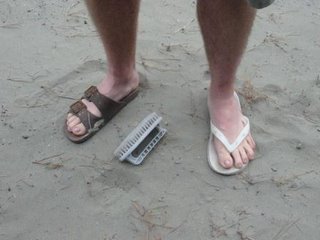Quail Island, within Lyttelton Harbour (Te Whakaraup), has an interesting cultural heritage in a unique natural environment. Named after the now extinct native Quail, the island was used for the collection of food - mostly seabirds eggs and fish - by the local Maori children. The Maori name for the island is O Tamahua, which means 'place to gather seabirds eggs'.
Today the island is home to native birds including the fantail, kingfisher, silvereye and many sea birds. To reach the island, you catch a boat from the not very attractive port of Lyttelton (where our container arrived all that time ago!) for a 15 minute trip over to the island. Here is a picture of one of the container ships about to leave.
The yellow arrow indicates the location of Sally and Seans' entire household which still hasn't left for the UK yet - Sally, just thought you might like to see it again!!!

As usual, Alex thoroughlyy enjoyed the boat ride and was very happy that from his position on the top deck, he could see the driver!

The walk round the island takes about 2 1/2 hours and takes in the remains of the leper colony which was set up in 1907 and was the only such colony in New Zealand. At its peak, up to nine sufferers were housed on the island. The remainss of a radio mast still stands, this was their onlycommunicationn with the mainland. One poor soul died on the island and was buried near to the colony.
The island was used for quarantine of humans and animals from 1847 when a quarantine station was built. Any person or animal coming in from England was held there until the chance of them passing on any sickness/disease was considered to have passed.
In 1901 and 1910, Robert Falcon Scott used the island as a base to train the dogs, ponies and mules for his Antartic expeditions. Ernest Shackleton used it for the same purpose in 1907.

The scenery is fabulous as the naturall harbour in which the island sits is surrounded by the port hills.

A brief rest at Walkers Beach before we catch the fast ferry back to themainlandd. Chris, Shannon and Alex got soaked on the way back as they insisted on standing in the area where all the boats spray came on board - mad or what?!?


 As usual, Alex thoroughlyy enjoyed the boat ride and was very happy that from his position on the top deck, he could see the driver!
As usual, Alex thoroughlyy enjoyed the boat ride and was very happy that from his position on the top deck, he could see the driver!
 The scenery is fabulous as the naturall harbour in which the island sits is surrounded by the port hills.
The scenery is fabulous as the naturall harbour in which the island sits is surrounded by the port hills.




 They had loads of lions and Tigers which Alex and his friend Max really liked. They are in the process of building a massive new lion enclosure and a matching one for the tigers.
They had loads of lions and Tigers which Alex and his friend Max really liked. They are in the process of building a massive new lion enclosure and a matching one for the tigers. This bird is a Tui - a native New Zealand bird. The zoo are trying to increase the numbers as is endangers, as are many NZ native birds.
This bird is a Tui - a native New Zealand bird. The zoo are trying to increase the numbers as is endangers, as are many NZ native birds. a fantastic pair of classy jandels and a brush suitable for scrubbing the most esteemed of floors. Did we find the glasses?
a fantastic pair of classy jandels and a brush suitable for scrubbing the most esteemed of floors. Did we find the glasses?